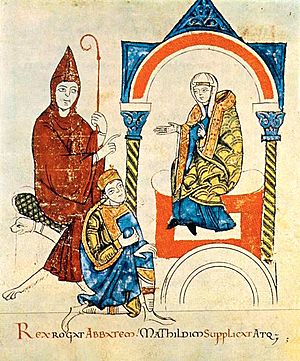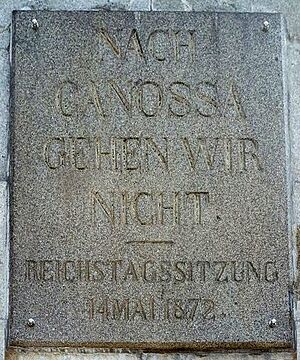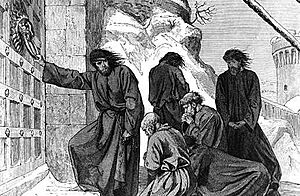Road to Canossa facts for kids
The Road to Canossa is a famous event from the year 1077. It describes the journey of Emperor Henry IV to Canossa Castle in Italy. There, he humbly asked Pope Gregory VII for forgiveness. This happened during a big disagreement between the Emperor and the Pope, known as the Investiture controversy.
Henry IV had been excommunicated, meaning he was kicked out of the Church. He needed the Pope to lift this ban. The Pope was staying at Canossa Castle as a guest of Margravine Matilda of Tuscany. Stories from that time say Henry waited outside the castle for three days and nights in a snowstorm. He was kneeling and begging for the Pope's mercy. This moment is seen as one of the most dramatic events of the Middle Ages. Historians still debate if it was a big defeat for the Emperor or a clever move.
Contents
Why Did Henry Go to Canossa?
The Pope and Emperor Disagree
For a long time, the Pope and the Holy Roman Emperor argued about who had more power. Was it the Church or the rulers of countries? This argument grew stronger in the 11th century with the Gregorian Reforms.
In 1073, Gregory VII became Pope. He wanted to change how bishops and other church leaders were chosen. He issued a rule called Dictatus papae. But Emperor Henry IV did not agree. Kings traditionally had the right to choose bishops and abbots. Henry insisted on keeping this power, even though the Pope had made a new rule.
The Conflict Grows Worse
The fight between Henry and Gregory became very serious. Henry had just put down a rebellion in Saxony in 1075. After that, he chose a new Bishop for Milan. This made Pope Gregory very angry. The Pope demanded that Henry obey him.
Soon after, the Pope was attacked and put in jail during Christmas celebrations in 1075. But his followers quickly rescued him. In January 1076, Henry gathered many German bishops in a meeting at Worms. These bishops decided to stop supporting the Pope. Henry then demanded that Pope Gregory step down from his role.
Henry is Excommunicated
In response, Pope Gregory took a big step. In March 1076, he excommunicated Henry. This meant Henry was no longer part of the Church. The Pope also said Henry was no longer the Emperor. He warned that if Henry didn't fix things within a year, he would lose his kingship forever.
Henry's Difficult Journey

Pope Gregory also said that all promises of loyalty made to Henry were now worthless. This was very dangerous for Henry. Many powerful princes in the Holy Roman Empire liked this idea. In October, some German princes met and swore they would not recognize Henry as king unless the Pope lifted the ban within a year.
Henry was afraid of more rebellions from the German nobles. He knew he had to get rid of his excommunication. People generally liked him, but the princes were threatening to choose a new king. He had to make peace with the Church before the Pope's deadline.
Crossing the Alps in Winter
Henry's advisors suggested he meet with the Pope. The Pope was traveling across the Alps towards Augsburg. Henry started his journey from Speyer. As he traveled south, he found himself in a tough spot. Nobles in Swabia refused to let him pass through their lands to the Alpine passes.
So, Henry had to go through Burgundy and cross the steep Mont Cenis pass in the Alps. It was the middle of winter. Stories say Henry, his wife Bertha of Savoy, and their young son Conrad risked their lives crossing the snowy mountains. After a long and hard trip, they finally reached Gregory's location at Canossa on January 25, 1077.
At the Castle Gates
When Henry arrived at Matilda's castle, the Pope ordered that he not be let in. Henry then began to act like someone asking for forgiveness. He wore a hair-shirt, which was a rough cloth worn by monks. He also supposedly walked barefoot in the snow. Many people with him, including Queen Bertha and Prince Conrad, also took off their shoes.
According to accounts from that time, the king waited at the gate for three full days. During this time, he wore only his hair-shirt and did not eat.
Forgiveness and Communion
Finally, on January 28, the castle gates opened for Henry. He was allowed to enter. Reports say he knelt before Pope Gregory and begged for his forgiveness. Pope Gregory forgave Henry and welcomed him back into the Church.
That evening, Gregory, Henry, and Matilda of Tuscany shared communion together. This was in the chapel of Sant'Apollonio inside the castle. This act showed that Henry's excommunication was officially over. It is not fully clear if Henry truly felt sorry for his actions. But he did get his freedom to act back. He quickly returned to Germany. Pope Gregory stayed with Matilda at the castle and in other places in Tuscany for several months.
What Happened After Canossa?

The immediate effects of the Canossa meeting were not very big. Henry was back in the Church, but the Pope did not immediately support his right to be Emperor again. In March, a group of powerful German nobles met. They decided that Henry had lost his imperial title. They said that a king's son should become king only if he is chosen by election, not just because he was born into the family. The Pope agreed with this decision.
Henry was still considered deposed, so he had to fight a civil war against Duke Rudolph of Swabia. Pope Gregory excommunicated Henry a second time. But Henry eventually won the civil war. He then marched into Rome and forced Gregory to flee. Henry replaced him with a new Pope, Antipope Clement III.
In 1728, Pope Gregory was made a saint. But the Pope's decision caused anger among European rulers. Emperor Charles VI even banned the news of it.
"We Will Not Go to Canossa!"

Later in history, the event at Canossa took on a new meaning. It became a symbol for Germany's refusal to be controlled by any outside power, especially the Catholic Church.
After Germany became a united country, Chancellor Otto von Bismarck had a big conflict with Pope Pius IX. This conflict was called the "Kulturkampf". In a speech, Bismarck famously declared, "We will not go to Canossa—neither in body nor in spirit!" This meant that Germany would stand strong and not let anyone from outside interfere with its politics, religion, or culture.
Canossa in Modern Language
Today, "going to Canossa" means to do something humbling or to give in, often unwillingly. It describes an act of asking for forgiveness or showing submission. For example, Adolf Hitler used this phrase to describe his meetings with a Bavarian leader after he was released from prison in 1924. He needed to get the ban on the Nazi Party lifted. In 1938, a British politician called Prime Minister Neville Chamberlain's meeting with Hitler "like Henry IV going to Canossa all over again."
The phrase is used in many languages, including German (Gang nach Canossa), Dutch (naar Canossa gaan), Danish, Norwegian, and Swedish (Canossavandring). It's also used in Finnish (ryömiä Kanossaan), French (aller à Canossa), Hungarian (kanosszajárás), Italian (andare a Canossa), Slovenian (pot v Canosso), Hebrew (הליכה לקנוסה), and Polish (idąc do Kanossy).
Images for kids



